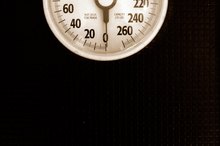What does fact checked mean?
At Healthfully, we strive to deliver objective content that is accurate and up-to-date. Our team periodically reviews articles in order to ensure content quality. The sources cited below consist of evidence from peer-reviewed journals, prominent medical organizations, academic associations, and government data.
- Centers for Disease Control and Prevention: Assessing Your Weight
- Medline Plus: Aging Changes in the Bones, Muscles, Joints
- Medline Plus: Weight Management
The information contained on this site is for informational purposes only, and should not be used as a substitute for the advice of a professional health care provider. Please check with the appropriate physician regarding health questions and concerns. Although we strive to deliver accurate and up-to-date information, no guarantee to that effect is made.
BMI, or body mass index, is a useful tool to help estimate body fat and determine a healthy body weight. However, there are circumstances under which BMI may be misleading because it only assesses total body weight and doesn’t account for body composition. There are some population groups, such as muscular athletes, for whom BMI may be an inaccurate assessment tool.
BMI
BMI is a number that can be calculated using your height and body weight. It is determined the same way for both men and women, regardless of age. BMI categories include underweight, normal weight, overweight and obese. The Centers for Disease Control and Prevention provides BMI values for each weight category 1. Individuals with BMIs less than 18.5 are considered underweight, BMIs 18.5 to 24.9 are normal or healthy weights, BMIs 25 to 29.9 are overweight and BMIs of 30 or above are considered obese.
- BMI is a number that can be calculated using your height and body weight.
- The Centers for Disease Control and Prevention provides BMI values for each weight category 1.
Determining BMI
How Much Should a Man Weigh?
Learn More
The American Dietetic Association website provides a formula that can be used to calculate BMI. The first step is to multiply body weight in pounds by 703; then divide this number by height in inches; and finally divide by height in inches again. The ending value is your BMI.
BMI and Muscle Mass
BMI may be an inaccurate assessment tool for certain population groups such as athletes or the elderly because it doesn’t take into account fat vs. lean body mass. Since muscle weighs more than fat, BMI may overestimate body fat in athletes with a high percentage of muscle mass, inaccurately putting them in an overweight or obese category. In the elderly, BMI may underestimate body fat since muscle and bone density tend to decrease with age, according to Medline Plus.
Body Composition Recommendations
How Much Should a 5'11 Male Weigh?
Learn More
Total body mass is composed of lean body mass which includes muscle, bone, organs, water and other lean tissue; the remaining portion of body mass is mainly body fat. Medline Plus states that the recommended body fat percentage for women is 20 to 21 percent, while the average American woman’s body fat is about 22 to 25 percent. For men, the recommended body fat percentage is 13 to 17 percent, while the average American man holds 17 to 19 percent body fat.
Determining Body Composition
There are several methods available to help determine how much body fat vs. lean mass you carry. BMI is a common and fairly accurate estimate of body fat percentage for most people. Other body composition tests include:
- CT scans
- DEXA scanning
- magnetic resonance imaging
- underwater weighing
- bio-electrical impedance
- skin fold measurements
- waist circumference
- waist-to-hip ratio
The AIDS InfoNet website provides more detailed information regarding each type of body composition test.
Related Articles
References
- Centers for Disease Control and Prevention: Assessing Your Weight
- Medline Plus: Aging Changes in the Bones, Muscles, Joints
- Lee SY, Gallagher D. Assessment methods in human body composition. Curr Opin Clin Nutr Metab Care. 2008;11(5):566-72. doi:10.1097/MCO.0b013e32830b5f23
- St-onge MP, Gallagher D. Body composition changes with aging: the cause or the result of alterations in metabolic rate and macronutrient oxidation?. Nutrition. 2010;26(2):152-5. doi:10.1016/j.nut.2009.07.004
- Clark JE. Erratum to: Diet, exercise or diet with exercise: comparing the effectiveness of treatment options for weight-loss and changes in fitness for adults (18-65 years old) who are overfat, or obese; systematic review and meta-analysis. J Diabetes Metab Disord. 2015;14:73. doi:10.1186/s40200-015-0154-1
- American Academy of Orthopaedic Surgeons. Female Athlete Triad: Problems Caused by Extreme Exercise and Dieting. http://orthoinfo.aaos.org/topic.cfm?topic=A00342.
- American Council on Exercise. Tools and Calculators. https://www.acefitness.org/acefit/healthy_living_tools_content.aspx?id=2
- Fahey TD. Fit & Well: Core Concepts and Labs in Physical Fitness and Wellness. New York: McGraw-Hill Education; 2017.
- National Heart, Lung, and Blood Institute. Assessing Your Weight and Health Risk. https://www.nhlbi.nih.gov/health/educational/lose_wt/risk.htm.
Writer Bio
Erin Coleman is a registered and licensed dietitian. She also holds a Bachelor of Science in dietetics and has extensive experience working as a health writer and health educator. Her articles are published on various health, nutrition and fitness websites.








